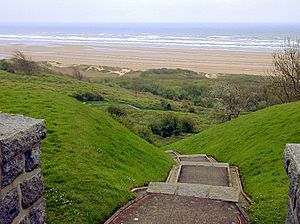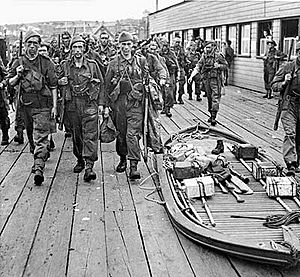Operation Aquatint facts for kids
Quick facts for kids Operation Aquatint |
|||||||
|---|---|---|---|---|---|---|---|
| Part of North West Europe Campaign | |||||||
 Omaha beach |
|||||||
|
|||||||
| Belligerents | |||||||
| Commanders and leaders | |||||||
| Strength | |||||||
| 10 British Commandos 1 Free Frenchman 1 Motor Torpedo Boat |
320th Infantry Division | ||||||
| Casualties and losses | |||||||
| 3 killed in action 1 killed in captivity 2 fate unknown 5 captured and survived |
Unknown | ||||||
Operation Aquatint was a secret mission during World War II. It was a failed raid by special British soldiers called British Commandos. They tried to land on the coast of France, which was controlled by Germany at the time.
The mission happened in September 1942, on a part of the coast that later became famous as Omaha Beach. The soldiers were from a special unit known as No. 62 Commando, or the Small Scale Raiding Force.
Just before this mission, a bigger raid on the French town of Dieppe had made the German forces very alert. This made Operation Aquatint much harder. The commandos also landed in the wrong place because it was very dark. Soon after they landed, a German patrol found them. The commandos had to try and get back to their boat, a Motor Torpedo Boat (MTB).
The MTB was also found by German guns on the shore. It was damaged and had to leave, leaving the commandos behind. Most of the commandos who weren't killed were captured. Only five of them survived the war.
Planning the Mission
After a big request from Admiral Louis Mountbatten, the head of Combined Operations, the Small Scale Raiding Force (SSRF) started doing special missions in 1942. These missions were meant to check out German defenses along the coast.
The SSRF had already completed three successful missions. Operation Aquatint was planned for a night in mid-September 1942. It was a reconnaissance mission, meaning its goal was to gather information. They wanted to learn about the area near Sainte-Honorine-des-Pertes, a small town in Normandy. They also hoped to capture a German guard. Airplanes had spotted some houses on the coast that seemed to be used by German soldiers.
The number of soldiers for the mission was limited by how many could fit on the Motor Torpedo Boat (MTB). The team included five officers, a warrant officer, a senior non-commissioned officer, three other soldiers, and one member of the Free French Forces. The leader of the SSRF, Major Gus March-Phillipps, led the raid. His second-in-command, Captain Geoffrey Appleyard, stayed on the MTB because he was injured from a past mission.
The Dieppe raid in August 1942 had changed how Germany protected the coast. The Germans saw how well their defenses worked at Dieppe. This made them focus more on building up the Atlantic wall, a line of defenses along the coast. They started making their gun positions stronger to protect against air attacks. Even though the area targeted by Operation Aquatint didn't have new concrete gun positions yet, it had many coastal artillery batteries. These batteries could fire together to cover the area. German soldiers also patrolled the areas between these gun positions.
The Raid Begins
The mission was first tried on the night of September 11/12, 1942. But it had to be called off because the commandos couldn't find their target in the dark and fog.
On September 12, 1942, their MTB left Portsmouth at 8:12 PM. It reached the French coast around 10:00 PM. The boat moved slowly to avoid being seen and to stay clear of hidden mine fields. They reached their planned spot just after midnight on September 13.
In the dark, they mistakenly thought a valley was their target, St Honorine. But it was actually Saint-Laurent-sur-Mer, about a mile away. Around 12:20 AM, the landing party headed for the beach in a small, foldable boat called a Goatley boat.
Once they reached the shore, they realized they were too close to some houses to leave their boat there. They dragged the boat about 200 yards east, away from the houses and above the high water mark. Captain Lord Howard stayed to guard the boat. The rest of the team checked the area to make sure it was safe and that no one had seen them land.
Ambush on the Beach
As the commandos headed back to the boat, they saw a German patrol of about seven or eight men coming from the houses. They quickly took cover. But a guard dog with the patrol found them around 12:50 AM. The German patrol immediately started firing at them with machine guns and throwing hand grenades.
The SSRF fired back and managed to make the German patrol scatter. They reached their Goatley boat. Captain Lord Howard, who had been guarding the boat, was wounded while trying to push it back into the water. The others managed to get him into the boat. The fight lasted about 30 minutes.
When the German patrol moved onto the beach, Lieutenant Hall tried to capture one of the Germans. But he was hit on the head and captured himself. The SSRF had to leave him behind, thinking he was dead.
The men in the Goatley boat had gotten about 100 yards out to sea when German machine guns from above the beach found them. A larger gun from the west also started firing. The combined fire damaged the boat, and it began to sink. The commandos tried to swim to the MTB, which had also been spotted and was under fire. They couldn't find it in the dark and had to swim back to the beach.
Winter was shot at again when he reached the beach and was captured. He was taken to German headquarters. There, he was put in a room with Captain Lord Howard and Desgranges, who had also been captured.
The MTB had moved out of range around 1:30 AM, but one of its engines was damaged by a bullet. After 10 minutes, it moved back closer to shore, hoping to pick up any survivors. But the Germans found it again around 2:30 AM. The MTB had to leave once more under heavy mortar and machine gun fire. Unable to find any survivors, it went back through the German minefield and arrived in Portsmouth at 10:00 AM.
After the Battle
On the morning of September 13, 1942, Winter and Desgranges were ordered to collect the bodies of the men killed on the beach. Out of the 11 men who went ashore, three were killed: Major March-Phillips, Sergeant Williams, and Private Leonard. Four were captured: Captain Lord Howard (who was badly wounded), Lieutenant Hall (also badly wounded), Winter, and Desgranges. Four others had escaped.
Later that day, Captain Lord Howard and Lieutenant Hall were taken to the hospital for their injuries. Winter and Desgranges were taken to Caen for questioning. At this time, the Germans didn't know that four commandos—Captain Burton, Privates Hollings and Orr, and Captain Hayes—had managed to escape capture and get off the beach.
The bodies of the dead soldiers were buried in the St-Laurent-sur-Mer cemetery on September 15, 1942. Only German and French police commanders attended the funeral. The Germans even set up a machine gun to prevent anyone else from coming.
After 10 days of questioning, Winter was taken to Rennes. Three days later, Captain Burton, Hollings, and Orr joined him there. These three had stayed together after their boat sank and were captured by a German parachute unit. Burton was sent to a prisoner of war camp in Germany. Winter, Hollings, and Orr were taken to Frankfurt and handed over to the Gestapo for more questioning. After that, Winter was sent to a prisoner of war camp at Memmingen. What happened to Hollings and Orr after that is still unknown. Winter and another officer escaped from the camp in April 1945 by pretending to be French soldiers. Desgranges also escaped and made his way through Spain to Britain.
Captain Hayes, who couldn't reach the MTB, swam away from the fighting. He came ashore near Asnieres-en-Bessin. He managed to avoid capture and found a local French family who gave him civilian clothes. They also contacted the French resistance to help him. Hayes was taken by train to Lisieux and after several weeks reached Paris. He was then moved along a secret escape route to the Spanish border, arriving in October 1942.
After crossing into Spain, Spanish border guards stopped him and handed him over to the Germans. Hayes was sent back to Paris and put in Fresnes prison. He was kept alone for nine months before being executed by a firing squad on July 13, 1943. Hayes was in uniform when he landed, so he should have been treated as a prisoner of war. But he was executed because of the Commando Order. This was a secret order from Hitler that said all commandos captured should be executed. After the war, it was found that Hayes had been betrayed to the Germans.
Despite the outcome of Operation Aquatint, the British believed the SSRF could still be useful. Command of the unit was given to the newly promoted Major Appleyard. By the end of 1942, most of the SSRF moved to Algeria and became part of the 2nd Special Air Service Regiment. Major Appleyard did not survive the war. His plane went missing while he was returning from a mission. This happened on the same day Captain Hayes was executed in Paris.
Images for kids



